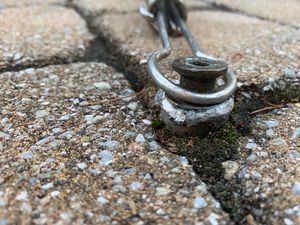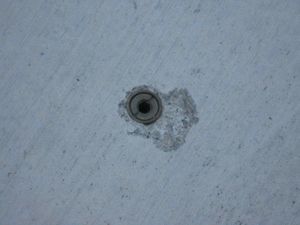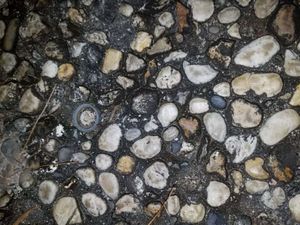(→Tools) |
|||
| (One intermediate revision by the same user not shown) | |||
| Line 12: | Line 12: | ||
Loop-loc recommends a silicone spray for lubrication and protection of the brass anchors. | Loop-loc recommends a silicone spray for lubrication and protection of the brass anchors. | ||
| + | |||
| + | ==Installation== | ||
| + | |||
| + | For pavers, core drilling is the only way to do it without shattering the pavers.<ref>https://www.troublefreepool.com/threads/pool-cover-anchors-in-paver-deck.196563/post-1810348</ref> Pavers should not be drilled through using a hammer drill in most cases because it will crack the pavers. Large, thick pavers might be ok, but some will still crack. Going in the joints usually works. | ||
| + | |||
| + | Core drilling is expensive and time consuming with installation cost about double. | ||
| + | |||
| + | If the pavers are mortared securely to a concrete base, you can use regular anchors. | ||
| + | |||
| + | For loose set pavers, you need anchor in pipe. Anchors in loose set pavers are not secure and the cover is not considered "safe" per manufacturers. Contact the manufacturer to verify their requirements for a proper safety rating. While most of the force is parallel to the deck, there is some vertical force applied, which will eventually pull up the pavers. | ||
| + | |||
| + | For regular anchors, you need to bevel the stone edge and sand down the anchor ridges some so that the ridges don't spall the stone. But, don't make the anchors loose. They still need to be snug. | ||
==Tools== | ==Tools== | ||
Revision as of 21:25, 22 May 2020
Pool Cover Anchors
Pool cover anchors are used to fasten the straps of winter pool covers to the ground or deck.
The anchors are typically brass. They screw down flush to the ground for the the pool season and screw out to provide anchor points for springs attached to the cover straps. Some older anchors are pop up type.
The brass anchors have different housings depending if they are going into concrete or pavers, or grass and dirt.
Concrete deck anchor casings are held in place by friction/tension. A 3/4" hole 2 1/4 inches deep is made in the concrete (standard deck assumed) but the top rim of the casing is slightly larger. When the casing is tamped in, it is squeezed and held in place.
9”, 15" or 18' pipes with a 1" OD are used to secure anchors to pavers, bricks, stone or grass. Meyco has 16" lawn spikes for planter areas and 18" lawn pins to go into soil.
Loop-loc recommends a silicone spray for lubrication and protection of the brass anchors.
Installation
For pavers, core drilling is the only way to do it without shattering the pavers.[1] Pavers should not be drilled through using a hammer drill in most cases because it will crack the pavers. Large, thick pavers might be ok, but some will still crack. Going in the joints usually works.
Core drilling is expensive and time consuming with installation cost about double.
If the pavers are mortared securely to a concrete base, you can use regular anchors.
For loose set pavers, you need anchor in pipe. Anchors in loose set pavers are not secure and the cover is not considered "safe" per manufacturers. Contact the manufacturer to verify their requirements for a proper safety rating. While most of the force is parallel to the deck, there is some vertical force applied, which will eventually pull up the pavers.
For regular anchors, you need to bevel the stone edge and sand down the anchor ridges some so that the ridges don't spall the stone. But, don't make the anchors loose. They still need to be snug.
Tools
A 1/4" Allen Key is used to turn the brass anchors.
A steel installation rod with a notch in the bottom that fits over the anchor is used to stretch the spring and stretch it over the anchor.
Removing the springe at opening should be as easy as fitting the installation rod inside the ring, twist till the end of the tool is between the ring and the stud, bend the tool towards the pool and the ring slides up the tool, lift and it falls off.[2] Often it is not that easy to get the right leverage and you need to insert the tool in the free space and kick with the side of your foot while twisting. You need boots on for that technique.
An alternative tool for removing the springs is using a spring puller T-handle with a 'J' hook on the end. Its used mostly to set up trampolines.[3]
Loop Loc has as aluminum tamp tool for installing brass anchors.
You can use a drill with a backwards screwdriver bit or a cut off allen key in it to loosen and tighten the anchors.
Repairs
Chipped Anchor Holes in Concrete
- Some chipping is normal with a hammer drill. The bit used, however, can make a difference.[4]
- Two bladed bits do not drill as clean a hole as a four bladed bit.
- Worn bits don't drill as cleanly as fresh, high quality bits.
- Good bits are expensive. So the final result is a function of the installer and his choice of tools.
- Best are four bladed Bosch bits and brass trim rings.
Trouble getting a 'screw-up' anchor to come up
- Make sure that the tool can go in all the way (i.e. - remove any sand or pebbles from the hole the 1/4" Allen wrench fits into) These anchors are brass and brass will 'strip out' easily, be sure that you have as much contact between the tool and the anchor as you can![5]
- If you can get the anchor to come up a little, blow out the debris in there and splash some water into the shell. This will wash away some more of the stuff that's clogging the threads. Turn the anchor back down, to allow the water to wash out more stuff from the other threads. Raise, rerinse and repeat until the whole anchor comes out - then rinse out the body of the anchor and the anchor's threads.
- If an insert will move at all, you can get it out. Just put some water on the screw and work it in by moving the screw back and forth until the water loosens the dirt. Be patient and keep adding water to flush out the grit and it will come out.[6]
- use a regular long allen key and insert the short side of the allen key into the anchor. Used the long handle of the install-removal tool to go over the long side of the allen key for more torque to unstick the frozen anchor.[7]
Anchor Housing Spins in Concrete
- Pull the whole thing out of the deck and lock onto the shell with channel locks or vice grips. Then work the anchor out as per above. Once the anchor has been freed and the threads cleaned and lubed, slide the whole thing back into the hole it came out of. [8]
Seized Anchors
The anchors can seize from sand and grit in the threads and not turn. Techniques to break it free include:
- Spraying with WD-40
- Spraying with Kroil Penetrating Lube from Kano Laboratories.
Anchors Stuck in Paver Tubes
Get a metal tube that exactly matches the diameter of the existing tube and put the tubes end-to-end. Then, put the tube on the ground and hammer the anchor out.[9]
Alternatively, put a metal rod inside the tube against the anchor and hold the tube and bang the metal rod against the ground.
If you use a heat gun on the tube, it will cause the tube to expand some and make the anchor pop out easier.
Anchor Head Snapped Off
To remove an anchor, first lightly score around the anchor to reduce contact with the deck.[10]
Then, drill and tap the center hole with a 5/16-18 tap. The drill bit and tap comes as a set. Drill bit size 17/64".
Then place a metal tube over the anchor. A 3/4" copper coupling should fit the scored area around the anchor.
Then, screw in a long 5/16-18 bolt with 2 big washers and a coupling nut above the washers. The bolt will need to be about 6 to 8 inches long to accommodate the anchor, coupling and coupling nut.
Then, hold the bolt and tighten the coupling nut to pull the anchor.
Scoring around the anchor a little bit and having the copper coupling sit in the scored area should reduce the risk of surface damage, but pulling an anchor always risks damaging the deck.
If you use a 3/4" hole saw to drill the top part of the anchor, that will remove the ridges around the top of the anchor, which will reduce the risk of surface damage.
To keep the hole saw steady without wobbling, you can first drill a hole in a piece of wood and then put that hole over the anchor then drill through the hole.
The hole for the anchor is 3/4", but the top ridges are slightly larger. So, when the anchor is hammered in, the ridges dig in and get compressed, which holds the anchor in place.
Hex Socket is Stripped
- If the bolt is stripped, from not inserting the bit deeply enough), you can drill them and use an easy out tool.
- Get a set of "screw extractors". Drill the appropriate pilot hole and the use the reverse threaded bit to extact the screw. If that doesn't work, keep drilling successively larger holes and eventually, either the body of the screw can be picked out or you will just drill the whole thing out.
- You can try to use a pair of channel locks to try to unscrew the anchor (wear glove to protect your knuckles when you slip off). Use lots of lubrication to try to make the job easier.[11]
Tips
- Anchors need to be out at least 1/2”
- The installation bar needs the anchor out 1/2” to work properly
- Do not screw the anchor back down after putting spring on. You need the anchor up to hold the spring against snow loads
.
- ↑ https://www.troublefreepool.com/threads/pool-cover-anchors-in-paver-deck.196563/post-1810348
- ↑ https://www.troublefreepool.com/threads/using-the-looploc-cover-tool.203065/post-1791614
- ↑ https://www.troublefreepool.com/threads/using-the-looploc-cover-tool.203065/post-1796689
- ↑ https://www.troublefreepool.com/threads/safety-cover-anchor-holes-with-chipped-concrete.79350/post-681971
- ↑ https://www.troublefreepool.com/threads/cover-anchors.16733/post-139112
- ↑ https://www.troublefreepool.com/threads/stuck-loop-loc-cover-anchors.175002/post-1543922
- ↑ https://www.troublefreepool.com/threads/stuck-loop-loc-cover-anchors.175002/post-1543950
- ↑ https://www.troublefreepool.com/threads/cover-anchors.16733/post-152207
- ↑ https://www.troublefreepool.com/threads/pool-cover-anchor-tubes.195144/post-1720197
- ↑ https://www.troublefreepool.com/threads/broken-screw-heads-in-pool-cover-anchors.175702/post-1550188
- ↑ https://www.troublefreepool.com/threads/cover-anchors.16733/post-138966




